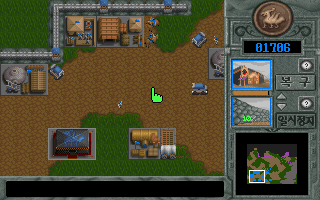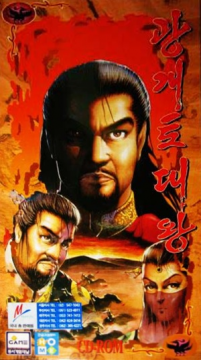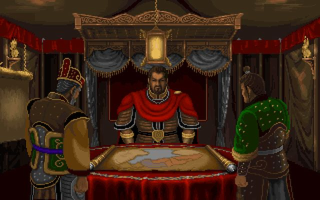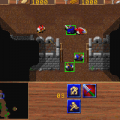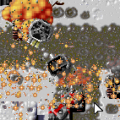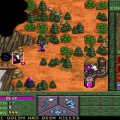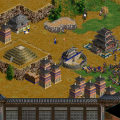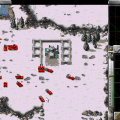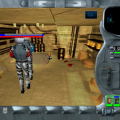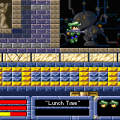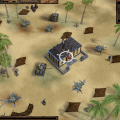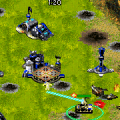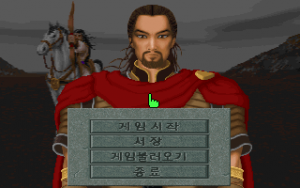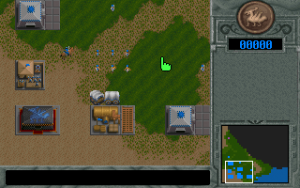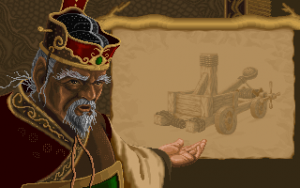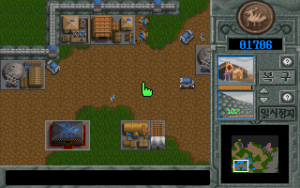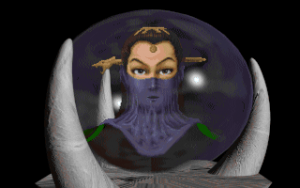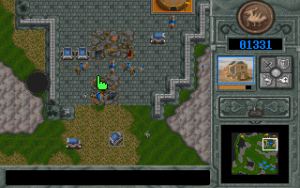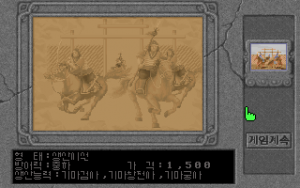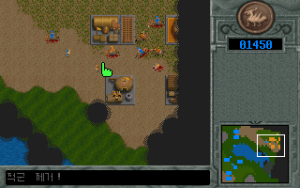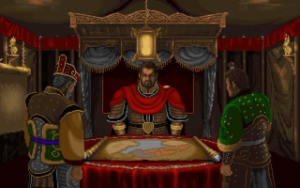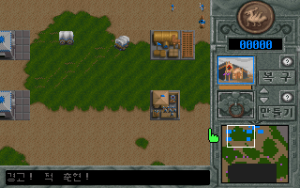Dune II may not have been the first real-time strategy game ever made – a title often bestowed upon Herzog Zwei, though there were even others before that – but it did codify the mix of base building, resource gathering, and unit control that inspired countless other real-time strategy games. One such game is Gwanggaeto Daewang, developed by DS Game Channel, the internal development team of Korean publisher Dong Seo Interactive. Dong Seo Interactive initially localized Western games, but started to develop its own titles in 1994, with Gwanggaeto Daewang being the first. The game’s name translates as “Gwanggaeto the Great”, a Korean king from the late fourth and early fifth century, and the protagonist of this title. While the game never received an official (or unofficial) translation or release outside Korea, some files refer to it as The Forgotten Land or The Forgotten Kingdom, and the former became its semi-official English name.
Gwanggaeto the Great, ruler of the Korean kingdom of Goguryeo, conquered a number of other states in the region and laid the foundations for Korea as the nation-state it would later become. The story of Gwanggaeto Daewang follows these historical events while taking certain liberties expected from a video game. Though this setup is completely different than the science fiction plot of Dune II, the game’s design is not. Like its inspiration, Gwanggaeto Daewang does not offer a multiplayer or skirmish mode. The only mode is the singleplayer campaign, which is divided into nine missions. For each missions, three different maps are available. Unlike in Dune II, where the player can pick their next target on a campaign map, Gwanggaeto Daewang picks a map at random upon completion of the previous mission. The sole exception here is the final mission, for which only a single map is available; once more a detail lifted from Dune II. The available technology for a respective mission never varies, though the difficulty does – often considerably so.
All missions have the same goal: The enemy’s headquarters needs to be destroyed and, if present, the enemy castle as well. Likewise, a mission is lost when the player’s headquarters is destroyed. The headquarters allows the player to construct new buildings via a menu in the side bar – in improvement over the Dune II construction menu, which takes up the entire screen. New buildings can only be placed within a certain radius around the headquarters, which the construction of multiple bases in Gwanggaeto Daewang not difficult, but flat-out impossible. Apart from the headquarters, the player has access to a supply depot used to drop of supplies gathered on the map (the game’s only resource), walls and towers, as well as a barracks, stables, and a workshop for the construction of war machines. Gwanggaeto Daewang has no tech tree. All buildings apart from the irreplaceable headquarters can be accessed right away, and so can all units once their respective production facility has been erected – provided they are available in a mission in the first place. As a result, almost no base building is necessary, and once a workshop and a supply depot have been built, unit production is all that is needed. Some missions even start the player off with these buildings, removing the need for base construction altogether.
The technology fielded by player and AI opponent is identical, though enemy infantry and cavalry units have their own portraits, which is a nice touch. The single exception to this rule is an infantry unit that can dig through the ground and pop up anywhere on the map. It only appears in the final mission and is an AI-exclusive unit. Initially, the only available units are infantry in the form of swordsmen, spearmen, archers, and flame archers. The stables add more swordsmen, spearmen, and archers, this time on horseback. These get soon replaced by the war machines from the workshop: A wooden tank, a huge automatic crossbow, a catapult, a flamethrower (which apparently existed in ancient East Asia in one form or another), and a ballista. The selection of units is significant, but Gwanggaeto Daewang falls into a trap that many real-time strategy games fall into: The lesser and cheaper units are fully replaced by the more powerful and more expensive units. Cavalry loses its value even as scouts due to their low durability, and infantry remains only useful for occasionally exploring rocky terrain, which – again as established in Dune II – is inaccessible to cavalry and war machines. Using only the powerful war machines is further encourages by their versatility, as the automatic crossbow and flamethrower are efficient against all units types. This removes the need for specialists such as the flame archer and the mounted spearman. Additionally, Gwanggaeto Daewang does not allow more than one units to be selected at a time. This gives an incentive to use as few units as possible, which means using the more expensive but powerful war machines.
The maps are all designed in the same way: The player starts out in one corner, with the enemy base being in the opposite corner. While the player gathers resources with the help of horse wagons, the AI opponent sends a steady stream of units towards the player’s position, attacking anything in its way more or less blindly. After the first couple of warm-up maps, the AI will have easy access to multiple supply stashes, making it necessary for the player to take the initiative. Unfortunately, Gwanggaeto Daewang strongly favors the defender over the attacker, which leads to a severe spike in difficulty halfway through the campaign.
The first player-exclusive obstacle is the omnipresent shroud of war. All units can only see a single tile ahead in the shroud, which makes exploration slow and tedious. Worse, no ranged units can shoot into the shroud, and units firing out of the shroud are not revealed. As a result, the player is required to get up close to any ranged enemy unit while the opponent has plenty of time to fire at them. Additionally, a unit needs to stop dead before it can start to attack, further favoring the defender. The AI is unaffected by the shroud, so defending player units never have this advantage. The only effective scouting unit is an infantryman strapped to a kite, resembling a ninja from popular fiction. The kite scout can fly over obstacles and is by far the fastest unit, but is only available in the last two missions and very expensive to make, which limits their use. Interestingly, the swords with which these kite ninjas are equipped are proof fatal against any structure for some reason. This can be exploited, and a map or two can be beaten by driving into the enemy base with a team of kite men and razing the enemy’s headquarters before the AI can react properly.
The second obstacle any human player who tries their luck with the campaign will soon learn to dread is the tower. Towers in Gwanggaeto Daewang are base defenses in their most basic form: They are placed on the map and shoot whatever enemy unit dares to enter their range. Said range is the tower’s distinguishing feature: Towers can shoot across the entire screen, outranging every unit in the game by a large margin – and this includes the catapult, the only unit highly effective against buildings apart from the elusive kite ninja. Whatever expert marksmen lurk in these towers, they never leave them, and all other archer units do not even come close to matching them. To be able to attack a tower, it first needs to be revealed, which means entering a tile right next to it. On some maps, this is difficult, as towers are protected by layers of walls and sometimes rivers. On other maps, some towers are entirely out of reach and thus indestructible, and the player is forced to send their troops through a hail of unstoppable arrows to reach the enemy base. These gauntlets do not only make some later missions incredibly difficulty, but add a level of frustration unusual even for the era of gaming Gwanggaeto Daewang is from.
The only unit able to counter the towers – though it still does not match their range – is the ballista, a war machine launching what appear to be sharpened logs at high velocity. The AI gains access to the highly destructive ballista halfway through the campaign. The player, on the other hand, can construct them only in the final mission. Until then, only hordes of units are sufficient to take down tower. Gwanggaeto Daewang has no population limits for units (except for a very high engine limit), but constructing an overly large army is discouraged nevertheless. Not only do all those units need to be moved individually, but there seems to be a cap on the maximum number of commands that can be executed simultaneously. Once too many commands have been issued, some units will simply stop moving until they receive a new order. Additional tedium comes from the precision required to use the attack command on an enemy unit for single-tile structure. Only clicking on the tile’s center leads to the command being registered correctly. For some reason, the game is a lot more generous when it comes to selecting a player unit. Here, any click on the respective tile will do the job.
Interestingly, the highly lethal tower is not only available to the player, but accessible quite early. However, its use is limited by the aforementioned building restrictions. Whereas the AI opponent starts with pre-placed towers everywhere on the map, the player can build them only in the vicinity of their headquarters. However, defending against the AI’s endless wave of units is not particularly difficult, making it unnecessary for the player to construct towers or walls. At the same time, it is difficult to simply hold out until the AI has depleted its resources, as later maps provide the AI with easy access to many more supply stashes than the player has. The end result is a game that strongly favors the defender, but requires the player to take the initiative in every single mission and exploit the AI’s weaknesses. Among these is the inability to replace destroyed buildings. Once an AI building has been razed, it will never be rebuilt, and even a failed attack can result in a strategic success if a couple of important AI buildings were destroyed. The developers were also kind enough to make the destruction of the enemy headquarters and castle the only victory condition, and not have the AI defend this building in particular. Thus, some missions allow the player to ignore large parts of the enemy base, destroying the enemy headquarters and moving on to the next mission. The AI also never uses units specifically against those units they counter. Flamethrowers may be effective against the other wooden war machines, and spearmen deal extra damage against mounted units, but the AI lets them attack whatever unit is closest, ignoring the game’s damage system.
Despite its grueling and highly unfair campaign Gwanggaeto Daewang, does offer a couple of treats. An animated cutscene preludes every mission. In these cutscenes, Gwanggaeto discusses the progress of the war with his advisors or consults Dae-Soon, the goddess of the moon, via a crystal ball – a game’s single supernatural element. The animation in these cutscenes is excellent, and they add character to a game that otherwise lacks it. They even add a little bit of comedic relief in form of the final antagonist, an overacting Manchurian king. Less memorable is the soundtrack. Gwanggaeto Daewang only offers a handful tracks, all of which play in an endless loop. Some are decent, others can be a bit too piercing and uncomfortable, especially when they loop over and over again. Equally unremarkable are the graphics outside the cutscenes. The units, structures, and landscape features look fine, even if the infantry units are a bit on a small and pixelated side. However, a single limited tileset is used for the every single map, once more in style of Dune II – which had the excuse of being set on desert planet.
A feature that makes the campaign more bearable is the retreat command. It allows a unit to recover health in the middle of the battlefield. While recovering health costs time and resources, this limits the need for the player to bring in reinforcements. Another interesting feature is the ability to cycle through the different commands for a unit with a click of the right mouse button. This makes issuing individual commands a bit easier and reduces the need to use the interface in a game that lacks context-sensitive commands. Nevertheless, these well thought-out ideas merely buffer the archaic gameplay of Gwanggaeto Daewan, and don’t allow it to get ahead of its peers. Whoever dares to challenge Gwanggaeto Daewang will not have to complain about a lack of playtime, though, especially when they intend complete all 25 maps. The later maps can take upwards of two hours complete. The total time it takes to complete the game is about 12 hours for a single playthrough, and 30 hours for all maps.
Gwanggaeto Daewang started its development shortly after Dune II saw the light of day and was initially scheduled for a release in early 1994. At this point, it would have predated WarCraft: Orcs & Humans and offered several improvements over Dune II. However, delays caused the game to be released no earlier than September of 1995, a month after Command & Conquer hit the shelves, and two months before WarCraft II: Tides of Darkness would be released. Both of these titles, as well as many other real-time strategy games that would shortly follow, made Gwanggaeto Daewang looked dated, which probably contributed to the fact that it was never released outside Korea. Nevertheless, the game was lauded domestically and received accolades for its depiction of Gwanggaeto’s conquests, and remains a milestone in the history of Korean gaming. Today, Gwanggaeto Daewang is hard to recommend even to hardcore fans of the genre and those curios about early real-time strategy games. Its archaic interface, unforgiving difficulty, lack a localization, and last but not least its rarity make the game difficult to access and probably not worthwhile accessing.
